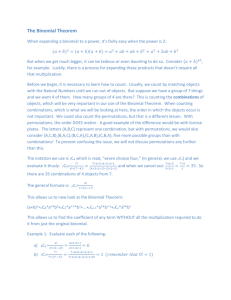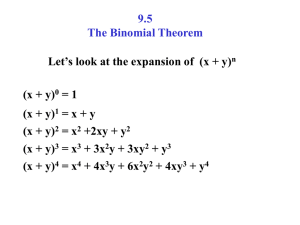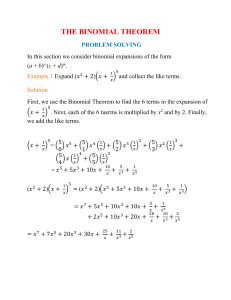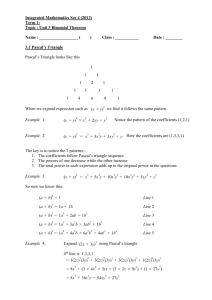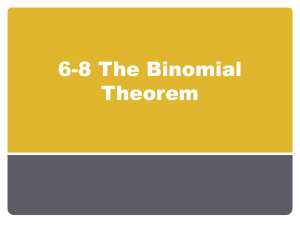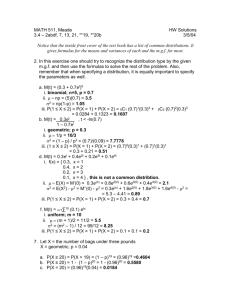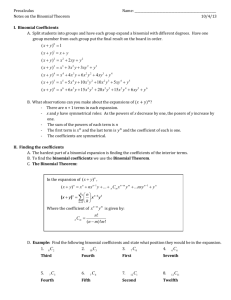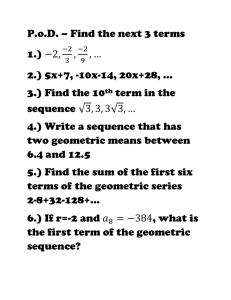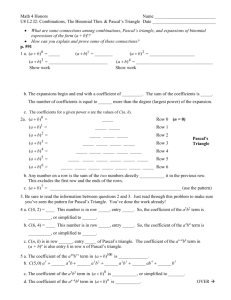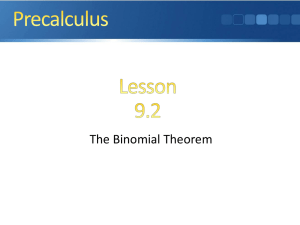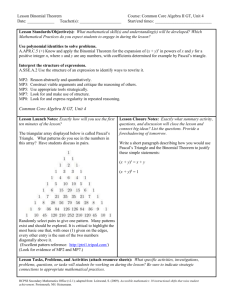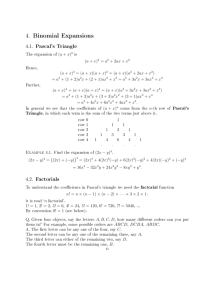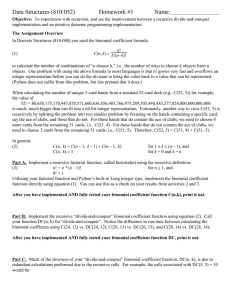Unit 3.2 The Binomial Theorem
advertisement
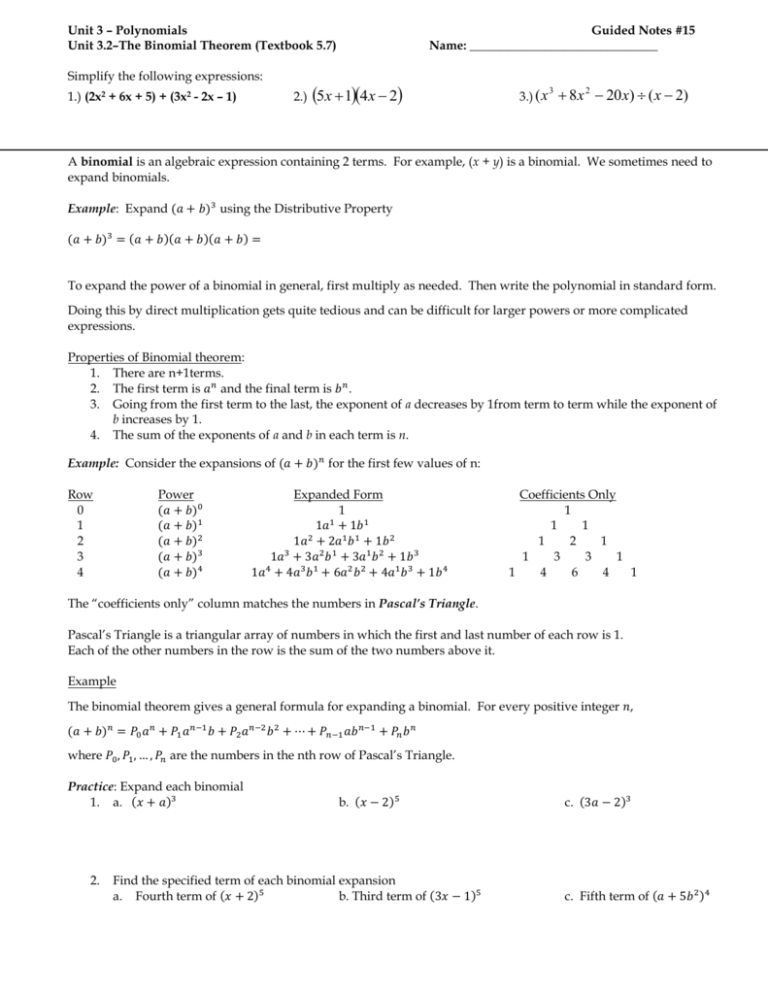
Unit 3 – Polynomials Unit 3.2–The Binomial Theorem (Textbook 5.7) Simplify the following expressions: 1.) (2x2 + 6x + 5) + (3x2 - 2x – 1) 2.) Guided Notes #15 Name: ______________________________ 5x 14x 2 3.) ( x 3 8 x 2 20 x) ( x 2) A binomial is an algebraic expression containing 2 terms. For example, (x + y) is a binomial. We sometimes need to expand binomials. Example: Expand (𝑎 + 𝑏)3 using the Distributive Property (𝑎 + 𝑏)3 = (𝑎 + 𝑏)(𝑎 + 𝑏)(𝑎 + 𝑏) = To expand the power of a binomial in general, first multiply as needed. Then write the polynomial in standard form. Doing this by direct multiplication gets quite tedious and can be difficult for larger powers or more complicated expressions. Properties of Binomial theorem: 1. There are n+1terms. 2. The first term is 𝑎𝑛 and the final term is 𝑏 𝑛 . 3. Going from the first term to the last, the exponent of a decreases by 1from term to term while the exponent of b increases by 1. 4. The sum of the exponents of a and b in each term is n. Example: Consider the expansions of (𝑎 + 𝑏)𝑛 for the first few values of n: Row 0 1 2 3 4 Power (𝑎 + 𝑏)0 (𝑎 + 𝑏)1 (𝑎 + 𝑏)2 (𝑎 + 𝑏)3 (𝑎 + 𝑏)4 Expanded Form 1 1𝑎1 + 1𝑏1 1𝑎2 + 2𝑎1 𝑏1 + 1𝑏 2 3 1𝑎 + 3𝑎2 𝑏1 + 3𝑎1 𝑏 2 + 1𝑏 3 4 1𝑎 + 4𝑎3 𝑏1 + 6𝑎2 𝑏 2 + 4𝑎1 𝑏 3 + 1𝑏 4 Coefficients Only 1 1 1 1 2 1 1 3 3 1 1 4 6 4 1 The “coefficients only” column matches the numbers in Pascal’s Triangle. Pascal’s Triangle is a triangular array of numbers in which the first and last number of each row is 1. Each of the other numbers in the row is the sum of the two numbers above it. Example The binomial theorem gives a general formula for expanding a binomial. For every positive integer 𝑛, (𝑎 + 𝑏)𝑛 = 𝑃0 𝑎𝑛 + 𝑃1 𝑎𝑛−1 𝑏 + 𝑃2 𝑎𝑛−2 𝑏 2 + ⋯ + 𝑃𝑛−1 𝑎𝑏 𝑛−1 + 𝑃𝑛 𝑏 𝑛 where 𝑃0 , 𝑃1 , … , 𝑃𝑛 are the numbers in the nth row of Pascal’s Triangle. Practice: Expand each binomial 1. a. (𝑥 + 𝑎)3 2. b. (𝑥 − 2)5 Find the specified term of each binomial expansion a. Fourth term of (𝑥 + 2)5 b. Third term of (3𝑥 − 1)5 c. (3𝑎 − 2)3 c. Fifth term of (𝑎 + 5𝑏 2 )4 Additional Practice: 1. Create Pascal’s Triangle to show the coefficients of (𝑎 + 𝑏)5 2. Expand each binomial completely: a. (𝑥 + 𝑦)6 3. 4. 5. b. (2𝑥 − 3𝑦)4 c. (𝑥 2 + 2𝑦 2 )3 d. (2𝑥 − 2𝑦)6 e. (𝑏 2 − 2)8 f. (3𝑥 + 8𝑦)3 Find each term described: a. Second term in the expansion of (𝑦 − 2𝑥)4 b. Fourth term in the expansion of (4𝑦 + 𝑥)4 Find each coefficient described: a. The coefficient of 𝑥 2 in the expansion of (2 + 𝑥)5 b. The coefficient of 𝑥 3 𝑦 2 in the expansion of (𝑥 − 3𝑦)5 Find the term: a. In the expansion of (𝑦 − 𝑥)4 , find the term containing 𝑦𝑥 3 . b. In the expansion of (𝑥 4 − 𝑦)5 , find the term containing 𝑥 8 𝑦 3 . Recap: In three complete sentences, explain how we can expand binomial expressions with large powers and the steps required to someone who was absent today. ______________________________________________________________________________________ ______________________________________________________________________________________ ______________________________________________________________________________________



